The basic nonuniformity of the cerebral cortex
- PMID: 18689685
- PMCID: PMC2527956
- DOI: 10.1073/pnas.0805417105
The basic nonuniformity of the cerebral cortex
Abstract
Evolutionary changes in the size of the cerebral cortex, a columnar structure, often occur through the addition or subtraction of columnar modules with the same number of neurons underneath a unit area of cortical surface. This view is based on the work of Rockel et al. [Rockel AJ, Hiorns RW, Powell TP (1980) The basic uniformity in structure of the neocortex. Brain 103:221-244], who found a steady number of approximately 110 neurons underneath a surface area of 750 microm(2) (147,000 underneath 1 mm(2)) of the cerebral cortex of five species from different mammalian orders. These results have since been either corroborated or disputed by different groups. Here, we show that the number of neurons underneath 1 mm(2) of the cerebral cortical surface of nine primate species and the closely related Tupaia sp. is not constant and varies by three times across species. We found that cortical thickness is not inversely proportional to neuronal density across species and that total cortical surface area increases more slowly than, rather than linearly with, the number of neurons underneath it. The number of neurons beneath a unit area of cortical surface varies linearly with neuronal density, a parameter that is neither related to cortical size nor total number of neurons. Our finding of a variable number of neurons underneath a unit area of the cerebral cortex across primate species indicates that models of cortical organization cannot assume that cortical columns in different primates consist of invariant numbers of neurons.
Conflict of interest statement
The authors declare no conflict of interest.
Figures





Comment in
-
Confusing cortical columns.Proc Natl Acad Sci U S A. 2008 Aug 26;105(34):12099-100. doi: 10.1073/pnas.0807271105. Epub 2008 Aug 20. Proc Natl Acad Sci U S A. 2008. PMID: 18715998 Free PMC article. Review. No abstract available.
Similar articles
-
Scaling of cortical neuron density and white matter volume in mammals.J Hirnforsch. 1997;38(4):513-24. J Hirnforsch. 1997. PMID: 9476216 Review.
-
Heterogeneity in the columnar number of neurons in different neocortical areas in the rat.Neurosci Lett. 1996 Apr 19;208(2):97-100. doi: 10.1016/0304-3940(96)12569-6. Neurosci Lett. 1996. PMID: 8859899
-
Number of neurons in individual laminae of areas 3B, 4 gamma, and 6a alpha of the cat cerebral cortex: a comparison with major visual areas.J Comp Neurol. 1989 Jan 8;279(2):228-34. doi: 10.1002/cne.902790206. J Comp Neurol. 1989. PMID: 2913067
-
Neuron densities vary across and within cortical areas in primates.Proc Natl Acad Sci U S A. 2010 Sep 7;107(36):15927-32. doi: 10.1073/pnas.1010356107. Epub 2010 Aug 23. Proc Natl Acad Sci U S A. 2010. PMID: 20798050 Free PMC article.
-
Not all brains are made the same: new views on brain scaling in evolution.Brain Behav Evol. 2011;78(1):22-36. doi: 10.1159/000327318. Epub 2011 Jun 17. Brain Behav Evol. 2011. PMID: 21691045 Review.
Cited by
-
Anisotropy of ongoing neural activity in the primate visual cortex.Eye Brain. 2014 Sep 23;6(Suppl 1):113-120. doi: 10.2147/EB.S51822. eCollection 2014. Eye Brain. 2014. PMID: 28539791 Free PMC article. Review.
-
Neuronal plasticity and thalamocortical sleep and waking oscillations.Prog Brain Res. 2011;193:121-44. doi: 10.1016/B978-0-444-53839-0.00009-0. Prog Brain Res. 2011. PMID: 21854960 Free PMC article. Review.
-
Forced G1-phase reduction alters mode of division, neuron number, and laminar phenotype in the cerebral cortex.Proc Natl Acad Sci U S A. 2009 Dec 22;106(51):21924-9. doi: 10.1073/pnas.0909894106. Epub 2009 Dec 3. Proc Natl Acad Sci U S A. 2009. PMID: 19959663 Free PMC article.
-
Distribution of neurons in functional areas of the mouse cerebral cortex reveals quantitatively different cortical zones.Front Neuroanat. 2013 Oct 21;7:35. doi: 10.3389/fnana.2013.00035. eCollection 2013. Front Neuroanat. 2013. PMID: 24155697 Free PMC article.
-
Constancy and trade-offs in the neuroanatomical and metabolic design of the cerebral cortex.Front Neural Circuits. 2014 Feb 11;8:9. doi: 10.3389/fncir.2014.00009. eCollection 2014. Front Neural Circuits. 2014. PMID: 24574975 Free PMC article. Review.
References
-
- Hofman M. On the evolution and geometry of the brain in mammals. Prog Neurobiol. 1989;32:137–158. - PubMed
-
- Mountcastle VB. In: The Mindful Brain. Schmitt FO, editor. Cambridge, MA: MIT Press; 1978. pp. 7–50.
-
- Hofman MA. Neuronal correlates of corticalization in mammals: a theory. J Theor Biol. 1985;112:77–95. - PubMed
-
- Catania KC, Lyon DC, Mock OB, Kaas JH. Cortical organization in shrews: Evidence from five species. J Comp Neurol. 1999;410:55–72. - PubMed
-
- Szentágothai J. In: The Neurosciences, Fourth Study Program. Schmitt FO, Worden FG, editors. Cambridge, MA: MIT Press; 1979. pp. 399–415.
Publication types
MeSH terms
Grants and funding
LinkOut - more resources
Full Text Sources

